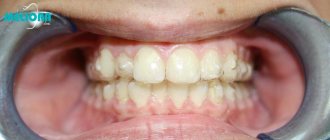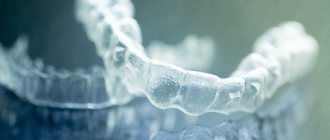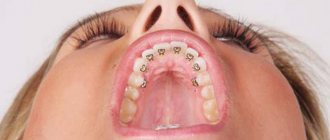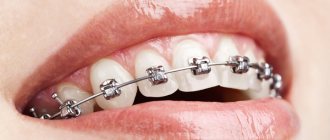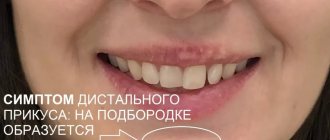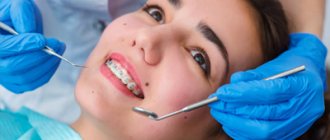Information about the brand and its manufacturer
The manufacturer of Invisalign aligners is the international company Align Technology, established in 1997 in the USA. It produces medical products. In addition to mouth guards, it manufactures intraoral scanners and also sells digital OrthoCAD services.
The products of this manufacturer are used by the best dental clinics in the world. The high quality of the product is confirmed by the fact that, since 1999, with their help more than 5 million people have effectively solved problems associated with occlusion.
Invisalign aligners are made from a clear polymer biosilicone. It is a medical grade thermoplastic material. It does not cause allergic reactions, and therefore products made from it are suitable for all people.
Read more about all the stages of bite correction with Invisalign aligners:
1. Initial consultation 30-60 minutes
- The orthodontist examines the position of the teeth and bite. — Talks in detail about straightening teeth with aligners. — Orients about the timing of treatment. — Takes impressions. — The patient pays for the invisalign aligners.
The orthodontist then draws up a treatment plan and makes recommendations. Sends prints by courier service from Rostov-on-Don to the head office of Align. There the prints are scanned. An individual virtual 3D model of the entire treatment is created - from beginning to completion. The doctor reviews the treatment plan, taking into account all the nuances - if necessary, asks to adjust it.
2. Second meeting in 2 weeks 30-60 minutes
— The patient is shown on video all stages of his treatment. — You can see the weekly movement of all teeth and the final result. — The treatment plan is approved by the doctor and the patient.
Invisalign creates your custom aligners. Sends them to a clinic in Rostov-on-Don.
3. Third meeting 4 weeks from the previous one 15-30 minutes
— The doctor gives two sets of mouth guards for both jaws and instructions for their use. — Shows how to use them.
4. The next orthodontist appointment occurs in a month, 10-30 minutes
— The progress of treatment is checked. — The following sets of Invisalign aligners are available.
5. Subsequent meetings occur approximately every 1.5-2 months
— If the patient leaves for a long period, then the number of mouth guards is given more - up to 4 months.
6. Final treatment session 10-30 minutes
— The latest aligners are used by the patient as a retainer.
Types of correction programs
The essence of the action of aligners is to move teeth in the process of synchronized directed mechanical action. At each stage of therapy, certain dental elements move according to a pre-developed plan.
There are 3 adjustment programs. They are differentiated depending on the complexity of the existing defect and, accordingly, on the number of aligners:
- SuperLite – up to 7 pieces;
- Lite – up to 14;
- Full – from 10 to 40 pieces.
The choice of program is made by the doctor, in accordance with the patient’s initial data.
How do aligners work?
The design of the aligners is based on data on the anatomical structure of the dentition obtained during a preliminary examination. As part of the treatment course, from 15 to 40 products are used, differing from each other in changes that take into account the intermediate results achieved during the correction. If in the case of braces the patient is forced to visit the dentist every one and a half to two weeks so that the doctor can change the arch or adjust the ligatures, then when using aligners everything is much simpler - just take a new pair from the kit, guided by the provided schedule and markings of the devices, and install it yourself on the dentition.
Braces are a permanent structure that cannot be removed without medical assistance and therefore must be worn around the clock. Orthodontic aligners Invisalign and Air Align also provide for long-term wearing - up to 22 hours a day, but the patient can remove them at any time when starting a diet or planning important negotiations. However, even when installed, they do not cause discomfort, since the thin and colorless polymer structure is practically invisible on the surface of the tooth enamel.
The duration of the treatment course using aligners is longer than when treating with braces, which is due to less impact on the dentition - the rate of tooth displacement in the bone structure is about 1 millimeter per month. However, much depends on the severity of the diagnosed defect - in the early stages, an attractive smile can be restored in just 9-12 months.
Indications and contraindications for treatment with the Invisalign system
Like any method, treatment with aligners has its own indications and contraindications.
Correction using the Invisalign system is indicated:
- in case of violation of occlusion, including with deep vertical overlap;
- in the presence of diastemas;
- with crowding of dental elements.
Aligners are not used:
- in correcting malocclusion in children under 12 years of age;
- in the presence of mental illness;
- for bone tissue abnormalities.
Invisalign, photos before and after use
You can clearly see the effectiveness of the technology in any center where Invisalign is used to straighten teeth. Photos before and after treatment are usually available in special catalogs. Although this can be done before visiting the clinic. If you are interested in the results obtained with the Invisalign system, photos before and after its use can be found on the Internet.
The photo clearly shows that after correction, the teeth become straighter or do not “crawl” over each other. Bite pathologies are also effectively eliminated using the Invisalign system. The photos clearly demonstrate this. In addition, you can verify the effectiveness of the Invisalign system before and after using it by reading reviews.
What is included in the diagnosis
Preliminary diagnostics in our clinic are performed using high-precision imported X-ray equipment ORTHOPHOS XG. This stage is necessary to identify indications and contraindications for occlusion correction using aligners.
The second stage of diagnosis is making individual impressions or scanning with an iTerro device, which allows you to create a 3D model of the jaws. Based on this model, personal mouth guards will subsequently be manufactured in production in the USA. When using this technology, there is no need to make physical impressions.
Based on the data obtained, a step-by-step therapy algorithm is developed using special software. ClinCheck technology allows digital interpretation to predict the progress of defect correction and visualize the final result. It should be noted that our clinic’s specialists are certified to use Align Technology products.
Indications for the use of Invisalign aligners
Despite what the Invisalign aligner advertising claims, these aligners still have narrower readings than any braces system. The patient must understand that there are pathologies that cannot be corrected with Invisalign aligners alone without the help of braces and orthognathic surgery. These include serious malocclusions:
· Distal (prognathic) bite. The upper jaw protrudes forward in relation to the lower jaw.
· Mesial (medial) bite. With it, the lower teeth move beyond the upper teeth. This type of jaw is called a “bulldog” jaw.
· Deep bite. The upper teeth completely cover the lower row.
· Lowering bite. A decrease in occlusal height due to intensive abrasion of tooth enamel, which results in excessive chewing load on the teeth, which leads to deformation and displacement of the alveolar processes.
· Open bite. With this pathology, there is no complete closure of the upper and lower dentition.
Problems that can be corrected with Invisalign aligners:
· Crossbite. A rather complex anomaly in which one part of the upper teeth protrudes above the lower teeth, while the other does not.
· Crowding of teeth. An anomaly in which the teeth are very close to each other, and there are almost no interdental spaces between them. This makes it difficult to carry out hygiene procedures. As a result, caries occurs and dental crowns begin to deteriorate over time.
· The presence of wide interdental spaces (three and diastemas). Large gaps between teeth look unsightly. In addition, food, which often gets stuck in these gaps, is an excellent environment for the proliferation of microorganisms, which provokes the development of caries and the appearance of inflammatory processes in soft tissues.
· Various forms of tooth curvature. Most often these are protruding upper central incisors, the so-called “rabbit” teeth, and protruding “vampire” fangs.
· Rotation and displacement of individual teeth.
How is the treatment carried out?
After the finished products are delivered from the USA to our center, the administrator notifies the patient about this by phone call and schedules an appointment time. With this visit to the orthodontist, the immediate course of correction begins.
The doctor explains the rules for wearing and the frequency of self-replacement of the aligners. The dentist also gives recommendations on how to care for your mouth and aligners. As a rule, the replacement is carried out by the patient himself once every 2 weeks. To check the effectiveness of the correction process, regular visits to our clinic are planned - approximately once every 1 - 2 months (depending on the complexity of the existing defect).
It is important for the patient to commit to wearing mouth guards daily and not to violate the recommendations of the attending physician. In addition, during the initial fixation of the corrective device and during its planned replacement, there may be a feeling of pressure on the teeth for several days. This phenomenon indicates that movement of the dental elements is initiated.
After achieving the result, a course of maintenance therapy is required, i.e. it is necessary to wear a retention device (or the last aligner from the kit). This consolidates the result and prevents the teeth from gradually returning to their original position.
Invisalign clear aligners and braces - a comparative analysis... Which will correct your bite better and faster?
When anyone realizes the need to correct their bite, the first thing that comes to mind is braces. And, to tell the truth, few people are delighted with these thoughts. It's quite clear why. Life with “hardware” in the mouth seems to many to be something terrible. And the search for alternatives begins. Is it possible to correct an adult's bite without braces? Is it possible to make this process less noticeable to others? Yes! Today we will talk about transparent aligners for correcting Invisalign bites .
Any potential orthodontic patient wants to find beauty right away, even without temporary sacrifices or any compromises. Any doctor would like to invite his patient to realize this dream. But is this possible? In this article I will try to objectively compare the bracket system and the Invisalign clear aligner .
First, let's try to understand the first questions that usually arise when mentioning this means of orthodontic treatment. How does treatment with invisible aligners differ from treatment with conventional braces? How to make the right choice? How Invisalign aligners really? What could be the pitfalls of treatment with removable aligners?
The first and most important feature of Invisalign is that the patient is much more responsible for the course of treatment compared to “braces.” The fact is that Invisalign aligners can be easily removed and put on yourself, without the participation of a doctor, whereas this is impossible to do with braces.
There are undoubted advantages to this fact. For example, there are no restrictions on food choice. You will be able to enjoy your favorite foods throughout the entire treatment period, chew kebabs, nibble nuts, indulge in toffees... in general, those with braces with their cereals, purees and yoghurts will definitely envy you at least during the lunch break. In addition, at a very important moment for you (wedding, public speaking, filming), etc. You will be able to remove the aligners and temporarily forget that you are an orthodontic patient.
But behind all these undoubted conveniences there are pitfalls. The effectiveness of your treatment will greatly depend on the intensity of wearing the aligners. If you are not confident in self-control, are subject to all sorts of temptations, the concept of “discipline” is not for you and you are afraid to regularly leave the race, leaving the mouth guards lying on the shelf or in your pocket, then this is not your method of treatment.
You must clearly understand that lying in your bag, the system will not work and your course of treatment will be disrupted. Then, you may have to make adjustments to the plan, “roll back” during the treatment process, order additional aligners, and this is a big plus to the duration of the entire treatment, and sometimes to its cost. This prospect is of no interest to either the patient or the doctor.
The second feature is the very method of moving teeth under the influence of aligners. When teeth move during treatment with braces, everyone understands: the bracket is attached to the tooth and hangs on the arch, the arch tends to straighten, the bracket slides along it, and with it the tooth.
{youtube}NSLx7dS4QZM{/youtube}
In this case, the doctor can act on each tooth separately. Essentially, he can move it anywhere (there are certain anatomical restrictions, of course, but that’s not the point now).
How does a tooth move during treatment with Invisalign ? Let's try to figure it out.
When scanning teeth, we receive 3D models of the jaws, then the technician uses a computer to implement a 3D model of the treatment result according to the “technical specifications” from the orthodontist. Next, the computer program creates a gradual transformation of the initial situation into the desired result.
{youtube}iTuXKi1b2Xw{/youtube}
This video captures the virtual treatment process. That is, roughly speaking, if you make a stop at every second of the video, then we will see minimal movements of the teeth during treatment; at each such “stop” an aligner is made that registers the new direction of tooth movement. Each subsequent aligner gradually guides the teeth into the desired position. However, the manufacturer himself warns about some limitations in the capabilities of Invisalign aligners, so only an orthodontist, after a thorough analysis of the pathology, can assess whether it is possible to cope with your particular problem with the help of aligners.
Due to the mechanics of tooth movement, it is sometimes possible to complete treatment if the teeth are not in ideal position. Such defects, in fact, can only be visible to a professional or a very scrupulous patient. Invisalign is a solution for those who are ready to improve the situation, almost imperceptibly for others, without changing their diction, without having food restrictions, but are also ready to accept possible small shortcomings at the end of treatment. This doesn't have to happen, but your doctor can't guarantee it because Invisalign's ability to position each individual tooth perfectly is somewhat limited.
It is worth noting that Invisalign aligners are an ideal solution for those who do not have serious problems with their bite, but have minor cosmetic flaws associated with uneven teeth. Usually, due to slightly rotated or tilted front teeth, few are willing to put themselves in a brace system, because even the simplest treatment usually takes several months. This means that all the inconveniences that accompany wearing braces will have to be endured for quite some time. For such patients, aligners are often the best solution.
Now a few words about the invisibility of the treatment process with aligners... What still cannot be hidden while undergoing Invisalign treatment?
1. The presence of special protrusions (attachments) on the teeth. The fact is that in order to improve the effect of the aligner on the teeth, the doctor must temporarily fix special attachments on the tooth (these are buttons made of light-curing filling material). They are almost invisible, but they are still there.
2. Sometimes, even when wearing mouth guards, there is a need for additional devices such as intermaxillary traction (elastic bands with funny animalistic names like “Elk”, “Antelope” or “Ram”, familiar to many orthodontic patients). In this case, a button is fixed to one of the jaws, a cut is made on the aligner of the opposite jaw, and an elastic is pulled between them.
3. In case of treatment involving tooth extraction, a tooth simulator is placed in the mouthguard in the “hole” area. It allows the patient to feel comfortable during the initial stages of movement, while the space is not yet closed. At the same time, I remind you that the patient always has the opportunity to remove the aligner during an important event. But here's the thing... after removing the mouthguard, you will be left without a tooth. I think that the patient in this case would prefer to be in a barely noticeable aligner rather than have a gaping hole in the dentition. Although this point can also be taken into account when planning treatment, if you warn the doctor about the approaching important event.
Many potential Invisalign users are concerned about the pain of the aligner treatment process. And here it must be said that when moving a tooth there will always be slight pain, regardless of WHAT it is being moved. Whether it's braces or aligners, the teeth will react in any case. The degree of severity of unpleasant sensations is very individual: some teeth will hurt more, some less, and no one has yet canceled the patient’s personal sensitivity; everyone’s pain threshold is different. Therefore, pain has nothing to do with the method of treatment. In this case there is no difference. Here you just need to return to the beginning of the note... if you are not patient and at the slightest inconvenience, in a fit of self-pity for your loved one, you remove the aligners, the treatment will be long and ineffective. With braces firmly glued to the teeth, this trick will not work, which means this system should be considered less sensitive to the degree of discipline of the patient. So, if orthotherapy cannot be avoided, and at the same time you are a sensitive nature, it is difficult to adapt to inconveniences and painful moments, once again it is worth weighing your readiness to resist the temptation to constantly remove the aligners, delaying the achievement of the final.
So, it's time to make the first generalizations. If you decide to make your smile beautiful, then the choice of treatment (aligners or classic braces) should be made after listening to the opinion of a professional. Braces have virtually no restrictions on the ability to move teeth; removable aligners still have some limitations. If in your case both treatment options are possible, and at the same time it is extremely important for you to make the process least noticeable to others, then Invisalign will cope well with this task! At the same time, it is important to remember one indisputable truth: the result of treatment largely depends on the specialist, and not on the patient’s choice of treatment. Remember that it is not the filling material that treats you, but the dentist-therapist, not the implant, but the surgeon, not the crown, but the orthopedist... The same goes for orthodontists - any orthodontic system itself cannot do anything without the knowledge and skills of a doctor.
If you have already chosen the Invisalign system as a means of correcting your bite, then you will probably have many questions at the beginning of treatment, and during the process too. In the next post I will publish answers to the most common of them. A unique FAQ on the Invisalign aligner system.
Author of the article: orthodontist Daria Kostina
Duration of therapy
The time required to obtain the final result depends on the complexity of the clinical case. On average, according to the official Align Technology website, it takes about 1 year, which corresponds to 24 sets of aligners.
The doctor can announce the approximate duration of therapy in a specific situation only after diagnosis and development of an algorithm for the treatment process.
General overview
Let's start with the fact that both braces and aligners, at their core, perform a single task. The purpose of their installation is to eliminate diagnosed pathological changes that worsen the aesthetic and functional characteristics of the jaw. In both cases, the design exerts targeted pressure on the problematic units, forcing them to move in a given vector, restores natural occlusion, and also helps eliminate problems with articulation. However, aligner models produced by the Italian company Nivol, as well as the American concern Align Technology, have a number of advantages that distinguish them from traditional devices for orthodontic correction.
Rules for wearing and care
Successful correction of occlusion is impossible without careful adherence to the orthodontist’s recommendations. Our dental center specialists advise:
- wear mouth guards daily for 22 hours;
- remove orthodontic products before eating or drinking hot drinks;
- brush or rinse the aligners with running water before each use;
- To clean the trays, use special pharmaceutical disinfectants or (if slightly dirty) a soft brush and paste. Note: Products cannot be boiled or washed with hot water;
- Use special containers for storage.
As you can see, the rules are simple and easy to follow.
Advantages and disadvantages
Invisalign systems have become popular for a reason. They really have many advantages, which has been proven by patient reviews over many years of practice. Here is the complete list:
- Reliable fixation in the oral cavity (due to the presence of special attachments).
- Fast and predictable results.
- High efficiency
- Aesthetics. Even at close range they are invisible when smiling and talking. This eliminates psychological discomfort for the patient during treatment.
- No pain.
- Hypoallergenic.
- Functionality. It is possible to carry out bleaching and remineralization procedures simultaneously.
- Easy care.
- Do not violate diction.
- Do not injure the oral mucosa.
The disadvantages include the high cost of the products. It is due to the use of expensive materials and the use of computer modeling. Also, the price includes shipping from the manufacturer.
Comparison of Invisalign aligners with braces
Another significant disadvantage is that manufacturing a set of aligners takes a long time.
Moscow aligners Avantis 3D
This system is well suited for a budget option for correcting crooked teeth (cheap cost compared to competitive manufacturers). The products are manufactured from bioplastic and biosilicon.
Correcting a bite with Avantis 3D aligners has the following range of positive aspects:
- Accuracy of parameters, which is ensured using 3D modeling;
- Integral transparent design that gives an aesthetic appearance to the patient;
- Cheap cost.
The disadvantages include frequent visits to the orthodontist (about 1-2 times a month) and the presence of restrictions in the scope of application.
This option for resolving dental problems is relatively inexpensive - the average cost of manufacturing and installing aligners varies between 170 thousand rubles.
The client must take into account that only a qualified dentist can tell exactly how much a certain method of teeth correction will cost and suggest which aligners are best suited in a particular situation after a thorough examination.
Caring for Invisalign Invisalign - hygiene secrets
There are no special rules for caring for the Invisalign system. It will be sufficient to soak the mouthguards in water to which a special solution developed by the manufacturer has been added.
If you don’t have the product, then thoroughly cleaning the aligners using a stream of running tap water will do. Wash off all crumbs and food debris from the surface of the mouthguard, free the material from germs. The product is ready for use.
When using Invisalign, your usual diet is not subject to correction, as happens after fixing braces on your teeth. The only caveat with mouthguards is chewing gum. It sticks to their base and is difficult to remove from the aligners. Therefore, chewing it is strictly prohibited.
Since the design is removable, there are no questions about hygiene. The aligners are easy to remove and brush your teeth as usual, minimizing the risk of tooth decay. As a bonus, the aligners can be “filled” with a remineralizing substance, paste or gel, to relieve the sensitivity of the patient’s teeth or prevent caries.
What are the advantages of treatment at Belgravia Dental Studio?
- Our orthodontists are certified specialists in Invisalign treatment.
- 3D scanning. No casts, absolutely comfortable. A digital scanner makes a “virtual” impression.
- 3D diagnostics on a digital tomograph with reduced radiation exposure.
- The result is BEFORE the start of treatment. On the 3D video you will see how your teeth will change (step by step!) and look like in the end.
- Preparation for aligners is also available with us, you don’t have to go anywhere. Therapeutic treatment (if necessary) from our dentists, professional hygiene from hygienists.
Are aligners really invisible?
Yes, they completely follow the shape of the teeth, so they fit perfectly and look like copies of the dental arches. Imagine contact lenses for the eyes - this is what aligners look like on teeth due to their transparency, thickness and precision of the contour.
This is especially true for people in public professions, managers, and patients for whom aesthetics is extremely important.
They are worn easily and discreetly, can be removed and put on independently by the patient, and are excluded during meals so as not to stain.
Appearance of aligners
The aligners are completely transparent and invisible. They are rightfully considered the most aesthetic type of orthodontic equipment. In addition, they can be removed during important events and activities.
Some aligners from the kits may have bulges on the outside and indentations on the inside - recesses for attachments. They are necessary for effective tooth movement. The attachment itself is a volumetric formation of composite material that is formed on the tooth, and at the end of the treatment it is removed with a special rubber head. By grasping the attachment, the aligner moves the tooth more efficiently.
